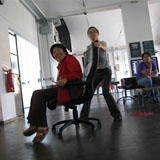Final touch

Ivrea, the innovative postgraduate institute for interactive design, is no more. Mark Delaney laments its loss and picks out a selection of highlights from the final degree show.
Earlier this month, the last 17 students graduated from the Interaction Design Institute Ivrea’s two-year Masters programme, marking the end of the school in its current form. As of September, the institute will merge with Milan’s Domus Academy’s one-year interaction design course and become known as simply the Interaction Design Institute.
This disappointment comes at the end of a difficult year, which saw Ivrea move from its home in Turin to Milan, the departure of course director Gillian Crampton Smith, and its students struggling with much reduced facilities. It is a credit to the students and academic staff, headed by Heather Martin and Neil Churcher, that, despite all of these problems, it was an outstanding show. All of the students passed, a record four with distinctions. Five of the students have already been snapped up by Ideo in the US and, over the course of the show, representatives of leading companies, such as Nokia, 3 Mobile and Vodafone, visited to discuss potential opportunities with students.
As you would expect, the students showed work that addressed a wide range of issues, each bringing a keen eye to bear upon the digital age in which we live. Open Builder, by Vinay Venkatraman, explores the concept of creating a service, which brings together open source technologies and social entrepreneurialism for the socio-economic development of the developing world.
His thinking revolves around the idea that small innovators in developing countries identify problems in their local area and then, through his Open Builder service, tap into a global network of experts to find a solution using open-source technologies. He showed an example of an electric wheelchair mechanism, which, if bought direct from the American manufacturer, would cost around £500, way beyond the means of the average person in the developing world. However, using his proposed Open Builder service, off the shelf components and local tradesmen in India, he managed to make exactly the same thing for about £50.
Nicholas Zambetti combines his background in software development and philosophy to create his Occasional Coincidences project (pictured top), starting with the observation that, as media consumption becomes more personalised, we are losing the collective, cultural rhythm that mass-broadcast television and radio used to create. As we are free to control our own media use, any coincidences of media choice become a meaningful indication of similarity between people. His project consists of a number of objects including the Musicincidence software application, which enables people to actively look for coincidences, such as other people playing the same song, artist, genre or even tempo of music.

Haiyan Zhang’s project, Control Freaks (pictured left), proposes a series of devices, which, when attached to everyday objects like doors or chairs, turns them into game platform controllers. Using motion sensors, the devices detect movement or vibrations in the host object and translate them into play commands controlling characters on-screen. Characters are moved from side to side by rolling around an office chair, a swinging door is used to control an on-screen bat and, if a device is clipped to clothing, the player’s own physical movements are mirrored on-screen. It is a testament to the success of the project that, on the opening night, her display was constantly swamped with players eager to take their turn.
While the demise of Ivrea is a huge loss to the global design community, its legacy will be long lasting. As the latest students land their first jobs, there is already talk of certain members of staff setting up a new Interaction Institute in Denmark, while others are forming new consultancies or moving into corporate positions. At a time when our world is becoming ever more digital and our interactions with technology more frequent and complex, the need for their talents has never been more necessary.
Mark Delaney is a director of strategic consultancy Plan
-
Post a comment




